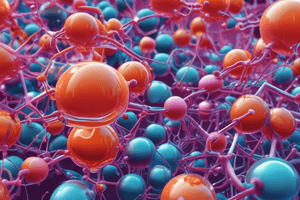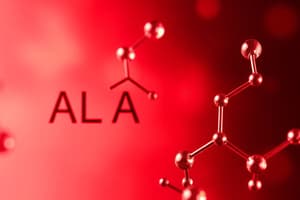Podcast
Questions and Answers
What is the percentage yield of ethanol for the fermentation reaction where 7.50 g of glucose produces 1.45 g of ethanol?
What is the percentage yield of ethanol for the fermentation reaction where 7.50 g of glucose produces 1.45 g of ethanol?
3.44%
What type of reactions do alkanes undergo?
What type of reactions do alkanes undergo?
substitution reactions
Calculate the overall percentage yield for the preparation of C from A if it proceeds by a two-step synthesis with yields of 80% and 70%.
Calculate the overall percentage yield for the preparation of C from A if it proceeds by a two-step synthesis with yields of 80% and 70%.
56%
What type of reactions do alkenes undergo?
What type of reactions do alkenes undergo?
Find the overall percentage yield for the preparation of D from A in a three-step synthesis with yields of 90%, 80%, and 60%.
Find the overall percentage yield for the preparation of D from A in a three-step synthesis with yields of 90%, 80%, and 60%.
Crude oil is formed from the decomposition of dead plants and animals subjected to intense pressure and heat, and is a mixture of thousands of: alkanes, alkenes, cycloalkanes, and _________ compounds.
Crude oil is formed from the decomposition of dead plants and animals subjected to intense pressure and heat, and is a mixture of thousands of: alkanes, alkenes, cycloalkanes, and _________ compounds.
What type of reaction occurs when an atom or group replaces another atom or group, forming a new substance?
What type of reaction occurs when an atom or group replaces another atom or group, forming a new substance?
What type of reaction occurs when two molecules are combined, resulting in the release of water?
What type of reaction occurs when two molecules are combined, resulting in the release of water?
Alkenes and alkynes are not very reactive.
Alkenes and alkynes are not very reactive.
What are proteins made of and how are they formed?
What are proteins made of and how are they formed?
Carbohydrates are condensation polymers formed by condensation reactions from __________ monomers.
Carbohydrates are condensation polymers formed by condensation reactions from __________ monomers.
What are lipids (fats and oils) composed of?
What are lipids (fats and oils) composed of?
Condensation reactions occur when two molecules combine and release water.
Condensation reactions occur when two molecules combine and release water.
What is the main structural component in cell walls of plants?
What is the main structural component in cell walls of plants?
What is the process of breaking down food and transforming it into energy called?
What is the process of breaking down food and transforming it into energy called?
Hydrolysis reactions occur when water is used to break a larger __________ into smaller products.
Hydrolysis reactions occur when water is used to break a larger __________ into smaller products.
Match the following components with the correct reactions:
- Proteins
- Carbohydrates
- Lipids
A. Amino acids to peptides and polypeptides
B. Condensation reactions between monosaccharides
C. Making triglycerides
Match the following components with the correct reactions:
- Proteins
- Carbohydrates
- Lipids
A. Amino acids to peptides and polypeptides B. Condensation reactions between monosaccharides C. Making triglycerides
Study Notes
Reactions of Organic Compounds
- Alkanes undergo substitution reactions, while alkenes undergo addition reactions.
- Substitution reactions occur when an atom or group of atoms replaces another atom or group of atoms, forming a new substance.
Types of Organic Reactions
- Substitution reactions involve the replacement of an atom or group of atoms with another atom or group of atoms.
- Substitution reactions can occur through free radicals, which require initiation, propagation, and termination steps.
- Alkanes are non-polar and hence not very reactive, but free radicals can initiate substitution reactions.
- Examples of substitution reactions include the formation of haloalkanes and the formation of alcohols from haloalkanes.
Addition Reactions
- Addition reactions occur when atoms or groups add across a double or triple bond, forming a new substance.
- Unsaturated hydrocarbons, such as alkenes and alkynes, are very reactive and undergo addition reactions.
- Addition reactions can occur with or without a catalyst, and examples include the addition of hydrogen chloride to an alkene and the addition of bromine to an alkene.
Pathways to New Products
- New products can be formed through substitution and addition reactions.
- Examples include the formation of secondary alcohols, ketones, and amines.
- Condensation reactions are also important in the formation of new products.
Oxidation of Alcohols
- Oxidation of alcohols occurs when an alcohol is oxidized in the presence of an oxidizing agent and a catalyst.
- Primary alcohols can be oxidized to aldehydes and then to carboxylic acids, while secondary alcohols can be oxidized to ketones.
- Tertiary alcohols cannot be oxidized.
- Strong oxidizing agents, such as permanganate and dichromate ions, can be used to oxidize alcohols.
Condensation Reactions
- Condensation reactions occur when two molecules combine, releasing water.
- Examples include the formation of amides (peptide links) and esters (esterification).
- Condensation reactions are important in the formation of biomolecules such as proteins, carbohydrates, and lipids.
Hydrolysis Reactions
- Hydrolysis reactions occur when water is used to break a larger molecule into smaller products.
- Hydrolysis reactions are the reverse of condensation reactions.
- Examples include the hydrolysis of proteins, carbohydrates, and lipids.
Biomolecules
- Biomolecules are molecules with biological function and include proteins, carbohydrates, and lipids.
- Proteins are formed through condensation reactions between amino acids and are important for structure, function, and regulation in the body.
- Carbohydrates are formed through condensation reactions between monosaccharides and are important for energy storage and structure.
- Lipids are formed through condensation reactions between glycerol and fatty acids and are important for energy storage and structure.
Condensation Reactions in Biomolecules
- Proteins are formed through condensation reactions between amino acids.
- Carbohydrates are formed through condensation reactions between monosaccharides.
- Lipids are formed through condensation reactions between glycerol and fatty acids.
Hydrolysis Reactions in Biomolecules
- Proteins can be broken down through hydrolysis reactions into peptides and amino acids.
- Carbohydrates can be broken down through hydrolysis reactions into disaccharides and monosaccharides.
- Lipids can be broken down through hydrolysis reactions into glycerol and fatty acids.### Hydrolysis of Carbohydrates
- A polysaccharide composed of glucose molecules (C6H12O6) has a molar mass of 3.2418 × 104 g mol–1.
- When the polysaccharide is hydrolyzed, 200 glucose monomers will be produced.
Hydrolysis Reactions of Biomolecules
- Triglycerides are broken down into glycerol and fatty acids during hydrolysis.
- One water molecule is needed for each ester link that is broken.
- The reaction requires a biological catalyst.
Efficiency of Reactions
- Efficiency of reactions can be measured by atom economy.
- Atom economy is a measure of how many of the atoms in the reactants end up in the desired product.
- Efficiency of reactions can also be measured by percentage yield.
Atom Economy
- Atom economy is calculated by dividing the molar mass of the desired product by the molar mass of the reactants and multiplying by 100%.
Percentage Yield
- The percentage yield is the amount of product produced in a reaction, expressed as a percentage.
- Theoretical yield is the maximum amount of product that can be formed using the stoichiometric ratios and assuming 100% conversion.
- Actual yield is the amount of product obtained experimentally.
Example Questions
- Calculate the percentage atom economy in the production of ethanol from chloroethane.
- Calculate the percentage yield of the combustion reaction of propene.
- Calculate the percentage yield of ethanol for the fermentation reaction of glucose.
Multistep Synthesis
- The overall yield of the product of a multistep reaction is found by multiplying the yields of each step and expressing as a percentage.
Pathways to New Products
- Secondary alcohols can be converted into ketones through oxidation.
- Primary amines can be converted into amides through condensation.
- Alkylammonium fluoride salts can be used to convert fluoroethane into ethylethanoate.
Reagents and Conditions
- Different reagents and conditions can be used to produce different products.
- Understanding the reagents and conditions required for different reactions is important in producing new products.
Studying That Suits You
Use AI to generate personalized quizzes and flashcards to suit your learning preferences.
Description
Explore how organic compounds are categorized, synthesized, and react in various ways, including combustion and substitution reactions. Learn about alkanes and alkenes, their properties, and reactions.



